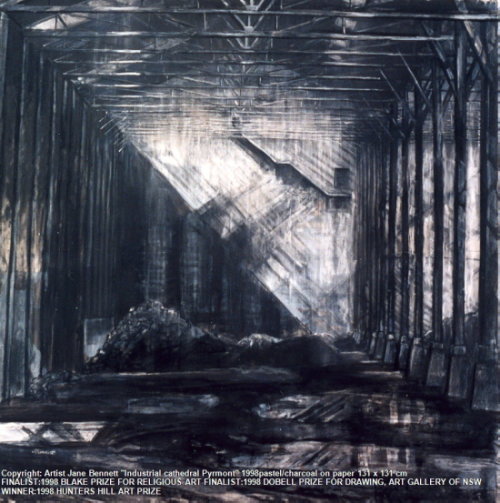 |
| GIHC16 'Detail Hammerhead Crane' 2014 oil on canvas 28 x 36cm SOLD PRIVATE COLLECTION : SYDNEY |
In my major solo exhibition "Under the Hammer" at the Frances Keevil Gallery there are several paintings of the Hammerhead Crane seen from various vantage points in the middle distance.
However, I also painted several canvases of close-up details that at first sight look like abstract works. I can assure you, they are completely realistic. They just focus on a tiny portion of the subject, unlike most of my work. These paintings have been wildly popular, but I wonder whether it is just because onlookers have become less capable of coping with the complexity of an entire scene, and are only able to appreciate a fragment.
 |
| GIHC18 'Girder, Hammerhead Crane 2014 oil on canvas 61 x 91cm FINALIST : 2015 HORNSBY ART PRIZE Enquiries |
Now I can't overstate how much I hate the flat picture plane!
And "modern" art has been all about "the surface", flatness and shallowness, in more ways than one.
In my paintings, I want depth, perspective and layers; physically, emotionally and intellectually.
So even in my canvases of close-up details, there are hidden depths and a sense of space extending beyond the picture plane, especially in the drawings and paintings I created while looking up, standing directly underneath the centre of the crane. I feel that the painting with the greatest sense of space and depth is "Under the Hammerhead Crane" seen below.
However these canvases of details of the Hammerhead Crane have given me the chance to reveal the transmutations, ambiguities and impermanence of form by the beauty of its decaying exterior.
 |
| GIHC20 'Under the Hammerhead Crane' 2014 oil on canvas 61 x 91cm Enquiries |
Patina is the visible sign of age on the surface of a material. It panders to our growing desire for the proof of authenticity; a backlash against the homogenized and generic corporate spaces that have taken over so much of our world. Materials are imbued with a history that speaks of ‘natural’ processes accrued over time, such as distressed wood, weather-beaten stone or brick, faded wallpaper, well-worn textiles, rusted ironwork, greening copper - the valued hallmarks of "shabby chic" in upmarket interior decor.
If you lose the texture, you lose your history.
The irony is that patina is seen as adding "authenticity", even though it has been caused by the degeneration and instability of the object.
I think of rust on a metal structure as though it is blood dripping from a wound.
Worship of patina can be seen as yet another symptom of the post-modern obsession with surface at the expense of ‘authentic’ depth.
Patina can be a by-product of the natural process of ageing, but it also functions as a memorial to disaster, natural or otherwise- the architectural equivalent of post-traumatic stress, showing the ‘wound’ inflicted by the trauma of the past as it reverberates down into the present.
Patina straddles the space and time between construction and ruin. The allure of patina lies in its instability; because any attempt to stabilise it affects the essential process.
The art critic Walter Benjamin said that the ‘real’ is only revealed in moments of ruination.
As with ruins, patina represents a fragment that suggests the meaning of the whole. Patina holds together contradictions, reveals historical depth, and yet ironically also remembrance and even healing.
Open from Tuesday 18th November – Sunday 7th December






%2Bcrop.jpg)















